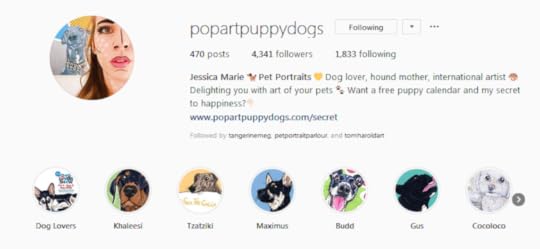Cory Huff's Blog: The Abundant Artist Goodreads blog, page 19
August 8, 2018
Resources for Writing a Solid Artist Contract
Having a solid contract ready to go for commission work is such an immensely important part of running your art business that getting started can feel overwhelming. How do you make sure you’ve included all the necessary verbiage, and haven’t left anything out that’s going to make the difference between a successful transaction and a huge mess?
We can’t write your contract for you, but we have a lot of resources to share that will help you write a solid artist contract that will serve you well, protect your business and keep your clients happy.
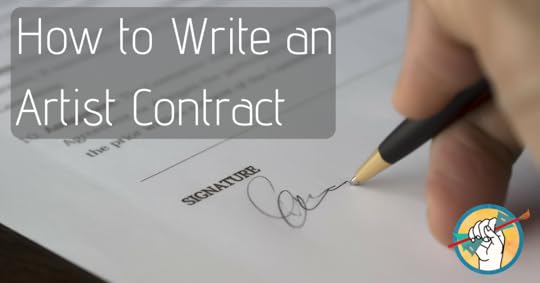
When Do I Need a Contract?
Any time you enter into an agreement in which you will produce work in exchange for money, goods, or something else of value, you need a contract in place. This post on contract law from the U.S. Small Business Administration breaks it down very simply.
Basically, in order for a contract to be legally binding:
Both parties must be in agreement
Something of value must be exchanged
Here is a (non-exhaustive) list of situations in which you would need a contract:
Signing with a gallery
Speaking engagements
Teaching workshops or classes
Private commissions
Licensing your art
Commissions from a business or nonprofit
Commissions from a government/public entity
Commissions from friends/family
Showing at an art fair or other exhibition
Note: If “contract” feels too formal or stiff for your business or you’re concerned about how your clients will react to signing a contract, just call it an “artist agreement” “commission agreement”, or something similar.
Resources for Writing Artist Contracts
*Asterisk denotes affiliate link
Writing a contract
*Art Licensing Info: Agreement Templates
The Abundant Artist: How to Not Get Stiffed (blog post)
Artwork Archive: What to Include in a Contract (blog post)
*Graphic Artists Guild Handbook: Pricing & Ethical Guidelines (book)
Graphic Artists Guild: Pre-Contract Checklist (blog post)
Reviewing a contract
Legal Clinic with Kiffanie Stahl (TAA Association Members Only)
*Understanding art licensing contracts (eBook)
Negotiating a contract
Artist’s Network: Negotiating the Contract (blog post)
Negotiation Tactics (TAA Association Members Only)
Do you have a contract template ready to go? What have you found are the most important elements to include? Let us know in the comments!
The post Resources for Writing a Solid Artist Contract appeared first on Online Marketing for Artists.
August 7, 2018
Lisa Frick: Art Furniture Sales Case Study
Lisa Frick is a painter whose canvas of choice at the moment isn’t a canvas at all: she creates whimsical and brightly colored pieces of custom-painted furniture. She has been a working artist for several decades as well as the proprietor of several boutiques and galleries.
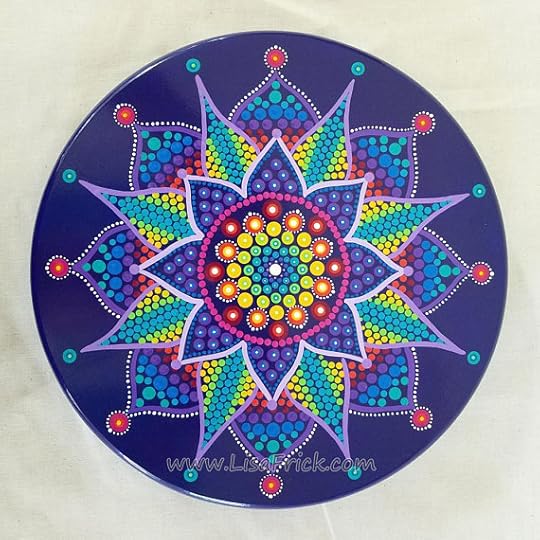
Lisa began putting her custom-painted furniture pieces into the world a few years ago, and at first sales were slow. She then took her first course with The Abundant Artist, and credits TAA with helping her keep abreast of the latest information on search engine optimization and social media promotion:
Lisa: “There’s always new information coming in from The Abundant Artist as far as SEO optimization and how to work the social media accounts. I take as much of that to heart as I have time for, and it does help me stay on top of all that. It really does help to stay on top of that and to promote yourself.”
As Lisa began to receive more interest in her work, she discovered that the colors she was most interested in using were not entirely aligned with what her customer base wanted:
Lisa: “When I started getting more commission work, I started getting a little idea of what people were looking for, maybe not the hot pink and lime green colors I liked to do, but more of the brick red and blue jean blue, and more muted colors.”
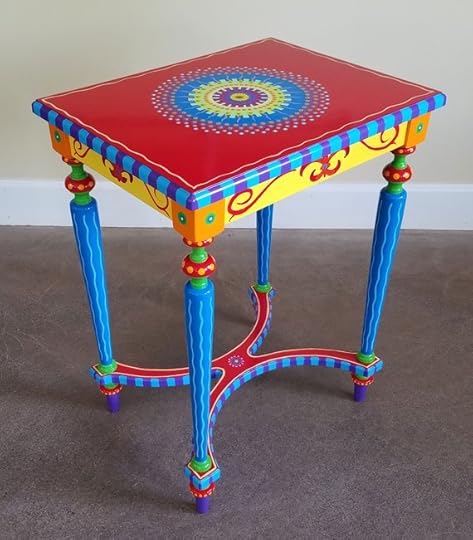
As she has continued to discover what is most appealing to her customers, she has also discovered the value of setting boundaries and recognizing when to respectfully decline a commission. Her ability to pass on commissions that do not align with her working style encapsulates the idea of living a creative life on your own terms.
Lisa shared with us that she has found another revenue stream in creating and selling tutorials as a digital download on her own website as well as Etsy. She sells several per week, and continually updates them with new information and techniques.
Lisa: “I do hand-painted furniture tutorials where I give out all my trade secrets: how I do my prep work, my priming, and the paint that I use, and I sell it for $25 bucks. I’m selling 2 or 3 of those a week!”
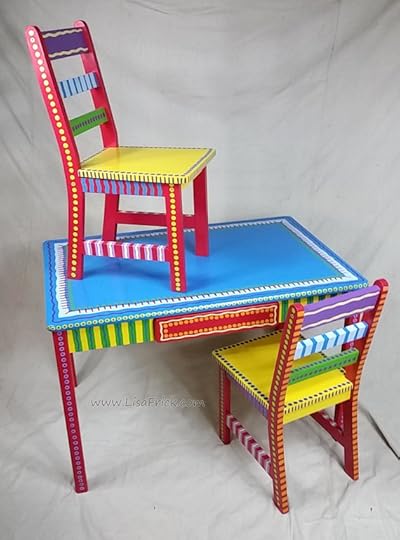
Lisa also shared with us that because of her location in the middle of Missouri, she is highly dependent on the Internet to make her sales. She currently isn’t selling anything locally at all- and yet she has commissions booked out for three months, and is making consistent sales on her work and tutorials through Etsy and her website. Lisa is proof that if you are willing to put in the work, it doesn’t matter where you are located: it is possible to make a living selling your art online!
Lisa’s parting advice for other artists is to be sure to ask your clients where they found you- keep track of where your traffic and sales are coming from so that you can adjust your promotional strategy accordingly. Lisa was surprised to find that much of her traffic comes from Pinterest and Google searches. Great job, Lisa!
 See more of Lisa’s work on her website http://lisafrick.com, or check out her Etsy shop http://etsy.com/shop/lisafrick
See more of Lisa’s work on her website http://lisafrick.com, or check out her Etsy shop http://etsy.com/shop/lisafrick
The post Lisa Frick: Art Furniture Sales Case Study appeared first on Online Marketing for Artists.
Tom Harold: Wire Ball Sculpture Sales Case Study
Earlier this year, rolling ball sculpture artist Tom Harold did what so many artists dream of doing: he quit his day job! (Way to go, Tom!) We interviewed Tom in early July to learn a bit more of his story and to learn about the trajectory that led him here.

Tom made his first piece for fun while working at a consulting firm. As he worked on it, he provided regular updates to a coworker who got very excited about seeing the finished product. (Proof that work-in-progress updates on your blog and social media can be a powerful way to garner interest in your work!) That coworker bought the second piece Tom ever created.
I’m definitely not naturally a salesman. But I was so excited about what I was doing that I was putting stuff out there.- Tom Harold
As he continued to create new pieces, Tom’s work received a lot of quick interest and people began commissioning pieces. At the time, Tom was working only in copper, which became a roadblock for him.
Tom: “Pretty early on I had people asking me to do more. The pay was okay. I wasn’t bringing down a thousand bucks or anything, and I probably wasn’t getting paid near what I should have been, but I’d do a piece for somebody and they’d pay me $300, and that’s money you can count, you know? So I just kept doing that, and I knew I was limited with copper. Part of it mechanically, soldering, and there were several practical aspects of it that didn’t quite suit me, but the big thing about it is that you can only build so large with copper. It’s really soft, so you have to keep adding supports and adding supports and adding supports, I wanted to build something like six feet tall. I wanted to do something big. And I loved the idea of welding.”
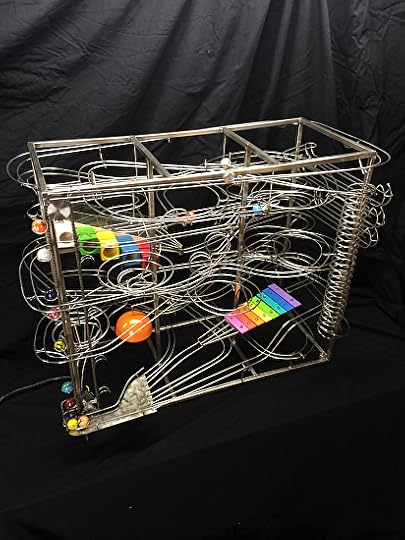
During this phase of his early career, Tom began to focus on investing in himself. When he realized that he needed to buy a $1200 welder in order to be able to work in steel and create larger sculptures, he made the difficult decision to sell a valuable and rare harmonica amplifier to raise the money. He also began to take welding classes. It was during this self-improvement period that he discovered The Abundant Artist.
Tom shares what TAA taught him and how it influenced his thinking:
Tom: “I know that I have learned a lot- I know a lot more than I realized. TAA has given me a realistic set of expectations, and that’s incredibly important. I now have what’s necessary to get from A to B, rather than just “oh, I heard this thing, I’m gonna try this thing, and I heard this other totally unrelated thing, and I’ll try that.” So there were a lot of things, like the thought process behind having your brand set up. When I got my website set up, I went and found TomHarold.com. I had to buy it from some guys, but I knew that I wanted it, because I wanted my name directly associated with that. I knew that was gonna be my brand, and that was really important to me.”
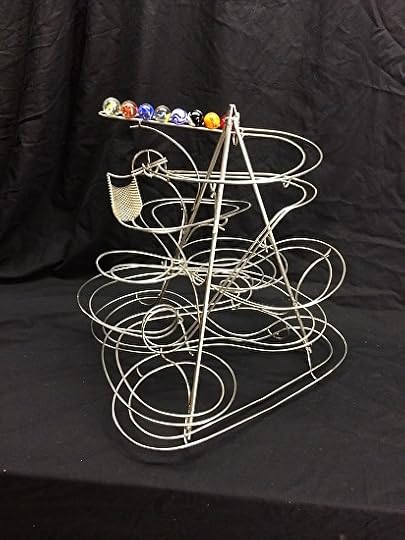
Tom: “One thing I learned was that people take you more seriously when you have a website that legitimizes their perception of you as an artist. Another thing I learned from TAA is that you want to have eighteen to twenty pieces in your portfolio as a really good starting point. There’s that mental shift- people are like “oh, this guy is pretty serious.” And learning how to present yourself online. My website still needs a ton of work, but I have all the basics down. I learned things about making it as easy to navigate as possible. And just presenting things in a clean format. I still think all the time- ‘Do people really read the about page?’ Yeah, they do.”
Tom shared that the greatest influence The Abundant Artist’s courses had was on helping him to develop the mental framework necessary to approach his art as a viable business.
As Tom’s pieces gained popularity and he launched his website and learned how to use Instagram, he realized that he was working hard on his art on nights and weekends. The workload in addition to his day job began to feel overwhelming. After a discussion with a friend, he realized that he was at a crossroads- quit his art, or quit his day job.
Within 3 days, he had made his choice.
Tom graciously composed a list for us of the top 20 lessons he’s learned from The Abundant Artist:
“You need a web site. People don’t view you as a “real” artist if you just have a FB page or Insta or whatever. Real business people have web sites.
You have to show people who you are. This includes putting pictures of yourself on your web site and social media posts and writing about yourself as well.
People WANT to know more about the artist him/herself. (Goes along with #2)
You need to interact with your followers on social media.
You need to come up with realistic pricing AND FEEL GOOD ABOUT IT! (Value yourself or no one else will, either.)
You need at least 18-20 pieces of art in your portfolio before people unconsciously feel like you are a serious artist.
You need to repeat yourself about all kinds of things in a way that may make you feel like you are a broken record, because people skip details or ignore things you post about, and they’ll need to hear it again and again. (I’ve been on IG for four years, and my profile states I’m an artist making these sculptures, and I post all the time about commissions, shipping work to clients, and all that. I STILL get people asking, “Do you sell these?” So every once in a while I make some mention that will make it rather obvious that I do sell my art. You have to repeat yourself.)
It is okay to ask for press from press sources (social media, TV, radio, magazines, papers, etc.)
It is okay to ask your followers on social media to do things for you like tell other people about your work. In fact, you NEED to do this, and people like to help you!
It is okay to state a price of a piece of art in one of your social media posts.
Don’t hide the pricing of your art. People would like to know how much it costs. You won’t scare them away, at least not the ones who are able to make a purchase. The ones who can’t, well, that’s okay, because you need to focus on finding the ones who can.
Don’t keep reworking something over and over again, delaying the release or announcement of it until you have it “perfect.” You’ll make much more progress by getting your initial plan together, carrying it out, making mistakes, then going back and fixing the mistakes, than you will if you keep reworking and waiting for “perfect.”
It’s okay to talk about yourself! If you do something awesome, like selling a piece or getting some press or getting a compliment/like/share from someone notable, TELL PEOPLE ABOUT IT. In fact it’s okay to tell them more than once! People don’t see it as bragging, and if they do, you can ignore those people.
Regarding point #13, your audience takes in that sort of news and really does use it to verify their feelings about the quality and desirability of your artwork.
If you don’t sound like you feel like your artwork is awesome and worth a million bucks (or even a couple hundred), then other people feel that, and it makes them back away. Again, this is bragging or being self-important. People buy art in large part based on the artist, and if you don’t feel your art is worthwhile, no one else will, either.
If you tell people to do something, like visit your web site or buy your art – THEY’LL DO IT! Not everyone, and not always, but they WILL do it.
You need to ask for the sale. This doesn’t mean beg, but if you post an available piece on social media, you canNOT assume that other people will assume it’s for sale and that they like the unnamed price. Simply state that it’s available and the price. You can get fancier later if you like, but this is perfectly acceptable for starters.
Sales methods or other efforts that work for some people may not work for you at all. Try something, see if it works, see how you like it, then do what works and what you like repeatedly as long as success and your feelings about it continue.
Don’t give your work away for exposure unless there’s a GREAT reason for it or unless you really just enjoy the opportunity. You can waste a ton of time and energy that way.
If you sell through second parties like Etsy or specific art web sites, you lose the ability to connect with your collectors and develop repeat business. You also lose the ability to get business from your collector’s friends, since you have no contact info for them! If you can market for yourself and develop your own leads, there’s no reason to pay someone else to do it. (Again, unless there’s a GREAT reason for it.)
There has to be a ton more, but I’ll stop at 20, because that’s a nice number. I thought Cory and the staff would like to get more detailed feedback. As I said in my interview, I often forget just how much I’ve learned, because I just feel like it’s natural knowledge now, but there was a time when I knew little or none of it. I’m armed with a good set of tools, including a supportive network, thanks to TAA.” – Tom Harold
TAA can help you not only learn the business skills, but develop the overall mindset that will help you succeed. Click here to discover which course is the right fit for you.
The post Tom Harold: Wire Ball Sculpture Sales Case Study appeared first on Online Marketing for Artists.
August 1, 2018
How to Write an Artist’s CV
A curriculum vitae is a necessary document if you hope to submit your work to galleries, collections, fine art exhibitions, etcetera.
In contrast with a resume, a CV highlights your professional accomplishments rather than your experience and qualifications. This is the place to list awards your art has received, exhibitions your art has been included in, collections where your art is held, and publications where you and your art have been featured.
For those whose art career hasn’t followed a straightforward trajectory of art school to professional career figuring out how to write an artist’s CV can feel intimidating. But it’s actually a really useful tool for you to highlight your accomplishments, conventional or not.
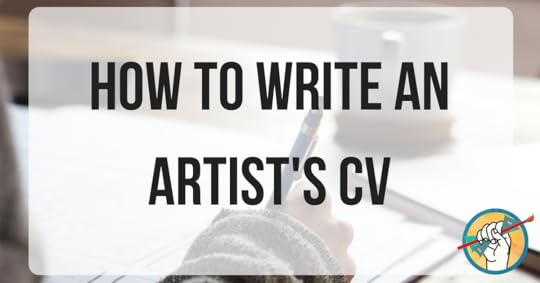
Header: Contact information
Keep this minimalist with a professional email address.
Leonardo da Vinci
555.555.5555
leonardodavinci.com
Education
Don’t worry- if you’re self taught, it’s okay to leave this part out. It won’t be considered a strike against you. If you’d like to include casual art classes or workshops you’ve attended here, the rule of thumb is to refer to them by the teacher you studied under, and not to draw attention to the more casual nature of the study. Only include education that’s relevant to your art career.
Example 1:
Studied under:
Andrea del Verrocchio
Example 2:
University of Oregon, Bachelor of Arts in Illustration, 2010
Exhibitions
This is the history of any exhibitions you’ve taken part in. If you haven’t yet partaken in any exhibitions, leave this out. If your work has been in more than 10 or 15 exhibitions, you can simply select the most impressive exhibitions to include. If you’ve taken part in 15 or fewer, you can list all of them. You can get creative here as long as you’re truthful- if your work was displayed in a coffee shop or a small private event, those are exhibitions.
It’s also acceptable to include exhibitions that you have lined up, but will happen in the future- list these as forthcoming.
2019 Leonardo da Vinci: A Life in Drawing, Belfast Royal Collection (forthcoming)
2018 da Vinci- The Genius, Boston Museum of Science
2018 da Vinci- The Genius, New Mexico Museum of Natural History
Collections
This is the place to list collections/museums where your work is held. This won’t apply to everyone, and it’s perfectly fine to leave it out. If your work is held in any collections, include the following information: title of the piece, name of the institution, city and state, and acquisition/donation date. It’s okay to include private collections as well- leave the name of the collector off in most cases and just include the location and the date.
The Last Supper. Convent of Santa Maria delle Grazie. Milan, Italy. Acquired 1490.
Publications:
Include here any publication you’ve had your work featured in- this includes newspapers, magazines, online articles, etc. If you’ve received a lot of published features, pick and choose the most impressive pieces to include here. If you’ve been featured in only a few, include them all! If you haven’t yet received any published attention, just leave this section off.
“Article title.” Publication title. Volume # (if applicable), date. Pages article appears on or link.
“The Secret Lives of Leonardo da Vinci.” The New Yorker. October 16, 2017. https://www.newyorker.com/magazine/2017/10/16/the-secret-lives-of-leonardo-da-vinci
Awards/Grants:
If you’ve received any awards or grants specifically for your artwork, include them here with the date first, followed by the name of the award and the awarding organization.
1495 The Leonardo da Vinci World Award, Leonardo da Vinci Association
Writing a CV when your art career is fairly new can feel intimidating. The key is to keep it simple and keep it relevant. Highlight your best accomplishments, leave off a section if it doesn’t apply to you, and remember that a CV is a living document and you will be able to update it regularly as you continue to work.
Do you have a CV written up, or have you used one to apply to galleries or exhibitions? What advice would you give to new artists looking to write their first CV? Let us know in the comments!
Need some more writing help?
How to Write Grants for Your Art Project
How to Write a Killer Sales Page
How to Write an Artist’s Statement that Doesn’t Suck
The post How to Write an Artist’s CV appeared first on Online Marketing for Artists.
July 30, 2018
How to Get Your Artwork in Front of your Customers Without Relying on a Gallery
Are you struggling to get your art displayed in galleries? Are you entering lots and lots of open submissions but it seems like an uphill battle to find a space to display your work? In this post I am going to share my methodology for how to get your art displayed in alternative spaces. This tried and tested approach is a fantastic way for artists to get in front of their target market and forge new business relationships. By following the steps outlined below, you too can successfully find alternative spaces to display and sell your work.
First, a little context. In 2016 I decided to launch my own art business to promote and sell my watercolour paintings. I re-entered the art market after 10 years of working in financial services and naively assumed the business of selling art hadn’t really changed. I immediately focused on submitting proposals with the aim of getting my work into galleries. After many weeks of knocking on gallery doors with little return, my confidence started to wane. Based on the sales I achieved in the lead up to my launch, I knew there was a market for my work but it seemed impossible to get into any of the fine art galleries within my key catchment area, Dublin.
My frustrations led me to think of alternative ways to get my artwork in front of potential customers. I started to read lots of articles about marketing art and quickly realized the art market had really changed. Artists were learning how to market and represent themselves as dynamic creative entrepreneurs, and they were selling their work without relying on gallery representation. These artists were identifying and partnering with alternative venues open to showcasing their art. I started to adopt this approach and I am now exhibiting in some of the trendiest restaurants, bars and arthouse premises in Dublin. This is how I did it.
Step 1 – Identify your Target Customer
The first thing to do, is to identify your target customer. I’m often surprised how many artists don’t take the time to think about their customer. It’s a key starting point to defining the marketing and business strategy that will enable you to achieve your creative goals. To identify your target customer, start by asking yourself the following questions:
1. How would you split your target market by gender? What percentage of your work is sold to men versus women? For example, if I analyse my sales from original art, I can confirm that 60% of my customers have been women and 40% have been men.
2. What is the typical age range of the majority of your customers? This is a rough estimate of an age bracket for example, you may identify that most of your customers typically fall into an age range of 35-45.
3. Where do most of your customers live? If you think back over what you’ve sold to date, can you estimate the split of customers by geographical region? For example, 50% of my customers are from Dublin, 20% from Europe, 10% in the West of Ireland and 15% in the South East of Ireland and 5% from the US.
Now that you’ve defined some parameters, imagine your target customer. Not as a statistic but as a real person. For example, when you consider your target customer you might imagine a cool trendy hipster woman in her late thirties, living in the city centre, with her partner and small child. Now hold that thought.
Tip: Many of the social media platforms you use have inbuilt data analytics features, so I recommend using these free tools to help inform your answers to the above questions.
Step 2 – Where would your target customer go?
Now that you can imagine your target customer as a person, think about where they might hang out during their free time. What venues would they visit to chill out, read, relax, play with their family, chat with their partner, eat and enjoy themselves. You should by now be building a clear picture of the types of places you can imagine your target customer frequenting. For example, our hipster female may enjoy visiting a boutique hotel for cocktails, a cool trendy restaurant, a plush salon, day spa, trendy coffee shop, quirky book shop and so on.
Step 3 – Which of the places frequented by your target customer might be a good fit for your art?
Next take a step back to think about your art. What kind of art do you make? Is it traditional, abstract, colourful, black and white, is it photography, is it punchy, edgy, minimalist, etc. What is the subject matter of your work, is it themed? Of the venues you imagine your target customer visiting, which venues might also be a possible fit for your art. Your ability to imagine your target customer will help you to refine the profile of the venues to consider. For example, there are many different types of hotels in a city. These range from 3 stars to 5 stars, some are located on the outskirts of the city and others are in the centre of the city. They have a specific brand to attract a certain type of clientele. You need to identify the key characteristics of the specific venue you imagine your target customer would frequent.
Step 4 – Make a shortlist
Once you’ve made a list of the criteria that would attract your target customer, you now need to get on Google and identify actual businesses in your target geographical areas that match your target customers preferences. Once you have a list of these businesses critically evaluate each one to consider whether your work would be a good fit for that particular venue.
For example, you might think of a really trendy coffee shop with great staff right in the hottest area in town. Brilliant! But then you go online and you look at the photos of the interior. You create 2mx1m abstract paintings and the café is half the size of your downstairs bathroom, and every inch of wall space is taken up with shelves and fittings. What does this tell you – this business does attract your clientele, they have a great brand which you would be proud to be associated with but it’s not a practical fit for your work, so you’ll have to rule it out and move onto the next venue on your list. As a result of step 4, you should have a shortlist of actual venues with the right brand, reputation, suitable space and aesthetic for your work (i.e. your work will compliment or fit in within the venues existing brand aesthetic).
Step 5 – Define your Pitch
Next pick the venue that you would most like to work with. The business with the type of brand and reputation that you would be proud to be associated with. Well that’s the venue you start with! Find out as much as you can about the business. Identify the business owner and get their email address. Understand their values and what they are passionate about. Now start to write your pitch to approach the owner and ask them if they would be interested in showing your work. The pitch is really important. The owner of the venue is also a business person so any proposal has to be commercially beneficial for them also. You also need to identify an angle – the commonality between what both of your businesses are trying to achieve.
The pitch must be professional but personable. Don’t be afraid to let them know what you admire about their achievements and outline a proposal which will be mutually beneficial for both of your businesses. For example, you could suggest hosting a joint competition on their social media channels to help promote your work and their venue. You could arrange a launch evening to help attract new customers for their business on an evening that may typically be quite or slow. These proposals will not cost the business owner any money, it will help promote their venue, introduce new customers and ultimately generate additional revenues.
Your proposal has to offer the business owner a win / win at no extra cost. Work on your pitch so its short, respectful, from the heart and clearly outlines the benefit for them as a business owner. Make it clear that you are not asking the business to purchase your artwork, you are only asking if they would be willing to display your artwork for a specific period of time. Once you are happy with your pitch, send it in writing and attach some images of your work and a link to your website. Also include an offer to meet with them face to face to discuss in more detail. Now be patient and wait. If you don’t hear anything within 2 weeks, give them a call to see if they had a chance to review your proposal. Make sure you follow up.
If you’ve done your research you should get a positive response. Make sure you remain professional throughout the partnership and deliver on your promises. This approach not only means that you are getting your artwork into places you are proud to be associated with, you are also networking and building invaluable partnerships with fellow entrepreneurs. Good luck.
 Artist Gill O’Shea at her art exhibition, Copper House Gallery Singe Street.
Artist Gill O’Shea at her art exhibition, Copper House Gallery Singe Street.Picture Colm Mahady / Fennells – Copyright© Fennell Photography 2016
Gill O’Shea is an award-winning Irish artist based in Dublin. In late 2016, Gill launched her art business ‘Dabble in Art’ offering art lovers a range of original paintings, limited edition fine art prints and commissions. She is a member of the Watercolour Society of Ireland and the Dublin Art Society. Gill will be exhibiting at the Dublin Horse Show and Art Source 2018 at the RDS later this year. To find out more visit Gills online studio – https://www.dabbleinart.com/
The post How to Get Your Artwork in Front of your Customers Without Relying on a Gallery appeared first on Online Marketing for Artists.
July 25, 2018
Color Management for Fine Artists: A Quick Primer
Color management when making art prints is ensuring that the color you see on your computer screen is true to the color that prints out on the paper. The tint and brightness of your computer’s backlight will influence the color you see as well as the color calibration of your screen, the inks and paper you use for printing, and your printer settings.
The basic goal of color management is to obtain a good match across devices.
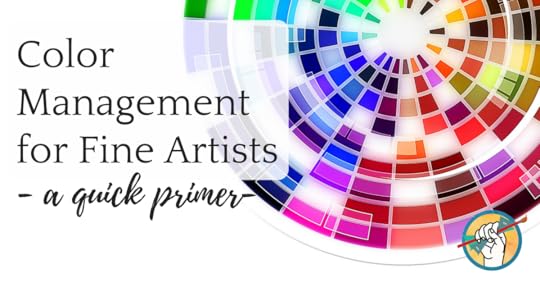
Why Do Fine Artists Need To Know About Color Management?
If you are using computers for any part of your art process, you need to know about color management. This is important for obvious reasons if you are creating your art digitally, but even a painter working in analog materials will need to scan their work to either display it for sale on the internet, or to create prints whether they print them on their own or send them to a print shop. If a screen is a part of your workflow at any stage of the process, you’ll need to understand at least the basics of color management.
Color management is a deep rabbit hole, but there are a lot of resources online (see below) and your local print shop will likely be happy to go down that rabbit hole with you. Members of the Association can take a brief trip down that rabbit hole in our conversation with Jeremy of the Los Angeles print shop POV Evolving.
The Basics of Color Management
Screen Calibration- Screen calibration is a process that calibrates your monitor closely with the colors you see in real life. This is a process that must be done periodically, and requires special equipment- often a colorimeter* or a spectrophotometer. If you are running a serious business creating your own prints at home, you may want to invest in the equipment necessary to calibrate your screen.
Color models- Sometimes called color spaces, these are the mathematical models used to describe color. You know them as CMYK, RGB, sRGB, HSB, and others. The colors available on a given printer are known as the “gamut”, and you’ll need to know how the color model you’re working in will translate to the printer gamut. Otherwise, you’ll see a noticeable difference in how your work prints versus what you see on the screen and on the original, if applicable.
More Information on Color Management
For a much more in-depth explanation of color management and how to calibrate your screen, choose the correct color model, and translate from one color model to another across devices, check out these resources:
A Practical Guide and Tutorial to Color Management for Photographers
Free Wacom downloads on color management
Color Management: A Comprehensive Guide for Graphic Designers by John T. Drew*
*Affiliate link
The post Color Management for Fine Artists: A Quick Primer appeared first on Online Marketing for Artists.
July 20, 2018
How Galleries Choose Artists
The art world, as well as the gallery system, don’t quite look like creative chaos. Although the review process may be unique in each gallery, it has some basics that have been around (and haven’t changed) as long as buying and selling art has been present.
Understanding the process of artist selection in galleries may help you prepare your work and submission materials, and simply put – optimize your chances for success. The method of selection is different in every gallery. Typically, galleries use three different review processes – the committee review, the partner review, and the owner review.
The Committee Review
The committee review is very formal and rarely used. It comes with strict submission guidelines and deadlines, and academic institutions or long-established commercial galleries mostly employ it. Galleries that use a formal review process only review work one or two times per year, and as an artist, you will most likely encounter them when entering shows or submitting to museum events.
In order to succeed, there are no tips and trick you can follow. You should carefully follow their submission guidelines and take a closer look at work of artists who have been accepted in the past. These galleries always look for consistency, so they will choose artists that have common characteristics with other artwork they have shown.
The Partner Review
In an established gallery, the artwork is reviewed by more than one person – usually the gallery director and the owner. The review doesn’t have to be formal. It is completely normal to occur via email or through casual interactions. The review can take from days to months, depending whether or not there is a strict deadline.
In order to succeed, the same applies as we mentioned above. Consistency and quality are two main factors you should focus on. While academic institutions will never take risks, in order not to jeopardize their reputation, established galleries are willing to take risks and lend credibility to an unknown artist.
The Owner Review
Early in your career, the owner review process is often the one you will encounter the most. This review process is often informal. The level of formality depends whether a gallery is relatively new and willing to take higher risks by bringing non-established artists. Smaller and newer galleries are led by the owner who is at the same time the director, the bookkeeper, the secretary and pretty much everything else.
Young galleries often become successful by bringing something new to the market. So, they are most open to risks, and unlike established institutions that look for similarity, they will accept a broader range of artists. Their review process is not structured, and the decision can often be made on the spot. Artists often stay with the galleries that have selected them before they were established.
Since this a far less formal review process, apart from the quality and originality of your work, you should also focus on your presentation, and ways to build chemistry between yourself and the owner. You must be confident in your work and enthusiastic. Since chemistry and first-impression are very important, it is advised to visit the gallery personally.
What Galleries Seek in Artists
Every gallery looks for artwork that will show successfully in their space. Success means different things for different galleries and institutions. Academic galleries are looking for publicity and community interest, and commercial galleries are looking for sales. Your goals should be the same as the goals of the gallery you want to approach.
Commercial galleries look for art that will sell well. Since that fact is rather hard to determine, they will consider things such as whether or not you have an established track record of sales. If you don’t have a sales history, they will judge the work by their own reaction to it. It is as simple as that. If they like it a lot, they will think others will like it to.
Price estimation is also important. A gallery won’t choose art that is dramatically more or less expensive than the work of other artists represented by the gallery. Lastly, they will consider whether or not your work brings something new. Although all galleries look for consistency, they are not looking for duplication. Ergo, your work shouldn’t be similar, but it has to offer similar quality and ideas etc.
Tips to Keep in Mind when Seeking Representation
To be completely honest, due to the unstable nature of the artwork review process, acceptance is in most cases is a matter of luck. In order to improve your chances, you have to be patient but also persistent. You have to make a lot of submissions and treat them like a marketing campaign.
Take Small Steps
Large institutions are rarely on a hunt for new and unknown talents. However, smaller galleries are. When looking for representation, contact smaller or emerging galleries that need your help as much as you need theirs.
Stay Visible
Show your work anywhere you can and make sure you participate in your local art community. Go to gallery openings, museum shows, tours, and actively visit all known art hangouts. Make sure you also maintain an online presence. Build a free website, and share your work on social media. In addition to increasing your visibility, it is very important to show your desire to participate and send people a clear message that you’re serious about becoming a successful and committed artist any way you can.
NOTE from Cory: Check out the interview we did with Jesse Reno. When he started his career, he showed in abandoned factories and anywhere with space. Now he’s world-renowned and highly sought after by galleries everywhere.
Collaborate
In order to build relationships with a gallery, collaborate by becoming an intern or volunteering. Work with local galleries that show art similar to yours. This is an excellent way to meet new people. You should also try collaborating (for example through volunteering) with established artists whose art you like and respect.
Build a Reputation
Best galleries only show the work of the very best artists. And the best artists are the ones who have proven themselves over time. The best artists always start hard. They show their work anywhere they can just to remain visible and they build their resume and portfolio patiently one line at a time. Over time, they have established a track record of successful shows which demonstrates that they’re capable of doing what’s expected when it’s expected. Simply put, they have established a reputation all by themselves. Never forget that galleries aren’t there to establish reputations of artists, they only assist in enhancing them. It’s up to you to prove that your reputation is worth enhancing. That is how the gallery system works.
About the Author:
 Mary Ann Cohen is considered one of the nations most successful and respected art dealers with over 35 years of International visual fine art experience. She actively encourages the use of art therapy in her galleries.
Mary Ann Cohen is considered one of the nations most successful and respected art dealers with over 35 years of International visual fine art experience. She actively encourages the use of art therapy in her galleries.
The post How Galleries Choose Artists appeared first on Online Marketing for Artists.
July 18, 2018
When High Website Traffic Isn’t a Good Thing
A new member of the Association recently had a question about her website traffic- she was seeing a surge in site visitors, maybe one or two new sign ups to her mailing list, but nobody was buying anything! Assuming that her website is set up and ready for loads of traffic to come and buy her art, what is she to make of this phenomenon?
It’s likely that there are a few factors at play: the way her art is displayed, ease of checkout, how well she’s communicating her story. But her experience highlights an important realization that high website traffic isn’t always a good thing. And this introduces the essential question: who is visiting your website?

Isn’t all website traffic good traffic?
For our intents and purposes, there are three types of website visitors:
People who buy something– this is the best traffic for obvious reasons. This may be someone you met at a show who later visited your site to buy a piece they’d had their eye on, someone who saw your work on Pinterest and fell in love, or perhaps even someone who found you through a Google search.
People who are interested, but don’t buy anything immediately. Brand awareness is an important part of the sales cycle, so don’t discount visitors who don’t buy anything outright. Google Analytics can help you gain a better understanding of who’s visiting your site and gauge their level of interest in your work.
People who will never buy something. This traffic is essentially meaningless. It includes bots and spam traffic as well as people who visit your site but never have any intention of buying your work. While it’s not necessarily hurting anything, it can skew your understanding of your website traffic, which can lead you to make incorrect business decisions or become complacent about the content and quality of your website.
How to attract the right kind of traffic
Here are a few steps you can take to start attracting traffic that will be more likely to result in sales:
Research your target audience. This is the most important part of the formula. Before you can effectively target your audience, you have to know who they are. Otherwise your marketing will be a little bit like throwing darts with your eyes closed.
Make interesting social media and blog posts that appeal to your target audience. Give people a taste of what they can find on your site- share snippets from a blog post, a series of work-in-progress photos or a process video. Intrigue people into wanting to see more. Here are some more ideas for great work-in-progress posts.
Retarget interested visitors who don’t buy anything. This is an advanced skill. Learn how to identify the pages that visitors to your site spent time on, and work on targeted ad campaigns to bring those visitors back to your site.
Need help figuring out who your target audience is? How to Sell Your Art Online 101 walks you through the process with exercises to help you identify your ideal collector… and increase your art sales!
The post When High Website Traffic Isn’t a Good Thing appeared first on Online Marketing for Artists.
July 12, 2018
Jessica Marie, Pop Art Puppydogs: A Case Study
Jessica Marie has been an artist and animal lover all her life and especially enamored with Pop Art, but it wasn’t until 2014 when she adopted a whippet, Finn, that her passions suddenly clicked together.
Jessica: “One day I was outside with Finn talking to my neighbor, who is a talented artist. We were talking about art and dogs, and in this moment I was overcome with the desire to paint Finn’s portrait. Prior to this I’d been painting a little bit since high school and going through uni, but at that time it was just a hobby for me. I never really knew what to paint and used to paint all sorts of random things. But after this conversation I painted Finn’s portrait, and it turned out like this:
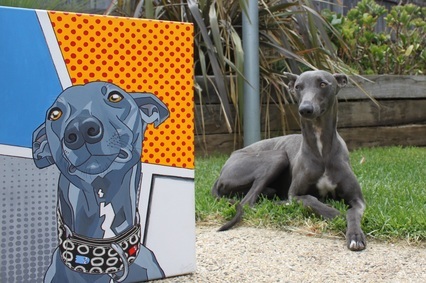
So I shared that on Facebook. I got a lot of likes from friends and family. I had a family member reach out to me and I ended up doing another one of their greyhound. And then that one went on some greyhound pages, groups around Facebook, and then all of a sudden I got another inquiry. So I did another painting. And it just really organically grew from there!”
Jessica shares this story beautifully and concisely on her website:
I realised that everything I learned in advertising could be applied to my dog portraits and I could spread the word to give others the opportunity to celebrate their own furry family members in art.
The missing piece of me had four paws and a wagging tail.
Pop Art Puppy Dogs was born.
Jessica shared with us that her website did not always communicate her story and her passion so clearly.
Jessica: “Pop Art Puppy Dogs grew slowly in the beginning just by word of mouth and social media and then I discovered your course. I have a marketing background, but specifically marketing art was something that I had a bit of a gap in my knowledge about. So it was really good to find specific information on marketing art in How to Sell Your Art Online. And applying these learnings to my Facebook and Instagram to kick that up to the next level.”
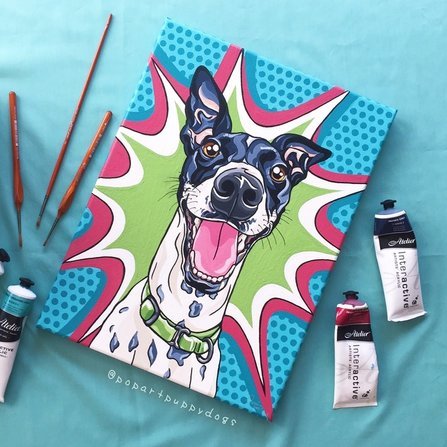
We asked Jessica for some of her biggest takeaways from How to Sell Your Art Online:
Jessica: “Most importantly, the importance of story. I pretty much rewrote my whole website after taking your course. Particularly the About page, the insights on how to tell your story and the artist’s journey were very very very good. So I spent a long time writing, I think I wrote three or four pages to start off with and had to condense it down to the essence of my story. I started off not really knowing what my story was and it was really delightful to discover I had one. I actually discovered what my artistic influences were and the life experiences that they came from and why painting dogs was what I was meant to be doing. I was able to articulate all this clearer on my website due to your teaching!”
Jessica really took this new storytelling skill to the next level on her Instagram page, where she uses Instagram Stories in a very creative way to showcase her pieces and bring in new business by appealing to lovers of specific dog breeds. Pictured here they are the circles under her bio- each is its own story with several parts.
After taking How to Sell Your Art Online, Jessica attended her first real art fair. She found that because she implemented what she was taught in the course, she was very well prepared with a cohesive brand across her website and social media accounts, prepared with an email marketing system in place, and ready to share her story and start making sales. At her very first art show she booked 10 commissions, and at the time that we interviewed her in June of 2018, she was already booked out for a solid 6 months and actively booking commissions for 2019. Way to go, Jessica!
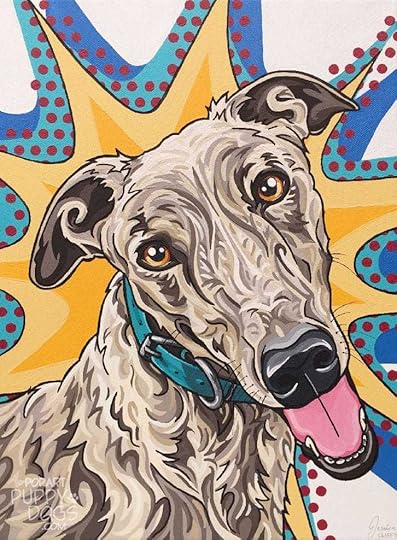
Jessica has taken her momentum and enthusiasm and is currently working to build a community for pet portrait artists- the Instagram handle is @petportaitparlour.
As a final note, we asked Jessica for any final feedback on the HTSYAO course and any recommendations she has for other artists.
Jessica: “I love the encouragement that your course gives us to step away from your easel and get to know the people who admire your art in your community. This, as well as the importance of story, you do really well. It’s been a journey, I did the course back in 2016 and have been working on implementing it bit by bit ever since.
I’m an introvert at heart – I suppose many artists are as well – and I know putting yourself out there can be a challenge for us. But I think if other artists can rise to this challenge too, you’ll be very surprised at the outcome. Connecting with your community, getting your story together and learning about all the different places that you can market yourself, like email list building, is an amazing asset to have. Once you can start to build your community and really just embrace the uncomfortable to be brave – the amount of opportunity that comes your way is glorious. You’ll be blown away.”
To find out if How to Sell Your Art Online is the right course for you, learn more here.

Jessica Marie paints pop pet portraits out of Melbourne, Australia. You can see more of her work at popartpuppydogs.com.
The post Jessica Marie, Pop Art Puppydogs: A Case Study appeared first on Online Marketing for Artists.
July 11, 2018
How to Write a Return Policy
Does your art website have a return policy? The specifics of your policy are entirely up to you (as long as it’s legal, see some resources on legality below.) Whether or not you decide to accept returned art, you’ll need to know how to write a return policy for your art business that will protect you and your art and keep your collectors happy. As you embark on writing your return policy, consider whether you should accept returns, decide on the specifics, and then enact some practices in your business to ensure you have to deal with as few returns as possible.

Should You Accept Returns?
As you decide whether you should accept returns, consider the value of your pieces as well as how much (on average) they cost you to create and ship. If a piece arrives to a customer in damaged condition, will it be worth it to you to ask them to send it back? Can your work be repaired if damaged? If the piece took a great deal of time to create and/or could be resold, you should accept the return.
What if a customer receives a piece and decides that it doesn’t work in their space? It may be tempting to refuse returns for undamaged art. Consider your relationship with this particular person- do you want to keep them as a collector? The answer doesn’t always have to be yes, by the way. If someone is toxic or a huge pain, it’s okay to thank them for their business and send them on their way.
If the answer is yes, it’s important to you to keep them as a collector, then make sure you have a policy in place that protects your business and will also keep collectors returning to you for the beautiful art and the pleasant and professional experience.
Writing Your Return Policy:
Consider the nature of your work: the size, the materials, and the value, and consider the most likely scenarios in which it may need to be returned (or which you have already experienced). Write your policy accordingly. This doesn’t have to be a lengthy Terms & Conditions page, but to protect your business and your reputation it’s important to have your policy written out clearly in an easy-to-find place on your website.
Will you ever offer a refund or partial refund without a return?
If this practice would ever make sense for your business (for example, if a small and inexpensive piece arrived damaged, you may offer a partial or full refund and allow the collector to keep the piece rather than go through the headache of returning it), be sure to clarify it in your policy. Returning artwork is a hassle, and if you don’t spell it out clearly it’s likely that an unhappy customer may simply demand a refund without a return.
Will you refund shipping costs or cover return shipping?
Whatever you decide, write this clearly into your policy. The customer will likely assume that if you accept returns, they will not have to pay to return a piece. If your policy is otherwise you will need to make it clear.
For what length of time will you accept returns?
Most retail stores operate on a 30, 60, or 90 day return policy. For a small business with limited cash flow, a shorter amount of time is a safer bet to ensure that refundable money isn’t accidentally spent. Also consider requesting that returns include tracking information and possibly insurance if the piece of highly valuable, and clarify that you will issue refunds upon safe receipt of the piece.
How to Avoid Returns
Once you have a return policy written, adopt business practices that will protect you from the need to give refunds and accept returns.
Consider offering installation services or consultations. If it’s a local collector, you can offer to bring the piece to them and let them try it out in their space. This would only be worth your time if it’s an expensive piece. If you want to offer consultations, factor the cost of your time and travel into the cost of the piece.
Mixed-media artist John Kraft offers installation and believes that it does wonders for an artist’s professionalism. He chats with us about it on The Abundant Artist podcast- check it out here.
Make sure you’re packing and shipping your art safely.
Research the safest way to ship your art, and take every necessary precaution to make sure that it arrives at its destination safely. Read this blog post with a video guide on how to safely package your art.
Let them preview your art on a wall.
There are a lot of apps out there, both free and paid, that allow you to preview your art in a furnished space. This is an excellent option to offer potential collectors that can not only protect you from returns, but can help you make more sales!
Make sure photos of your art are high quality.
Take good photographs of your work as you’re listing it on your website to ensure that collectors will know exactly what they’re receiving.
Resources:
We created a sample return policy you can copy/paste into your own website. Get it in the Free Resource Library.
Return/refund laws by state: https://consumer.findlaw.com/consumer-transactions/customer-returns-and-refund-laws-by-state.html
Be mindful of the default return policy if you’re selling on a POD or art marketplace site. Example- Etsy https://help.etsy.com/hc/en-us/articles/360000572888-Refunds-Returns-and-Exchanges-for-Sellers
The post How to Write a Return Policy appeared first on Online Marketing for Artists.
The Abundant Artist Goodreads blog
- Cory Huff's profile
- 31 followers


